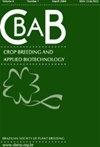基于预测遗传值的加勒比松子代选择
IF 1.1
4区 农林科学
Q3 AGRONOMY
引用次数: 13
摘要
利用REML估计的遗传参数,采用混合模型选择巴哈密松子代,用BLUP预测加性遗传值。实验设计是一个11 x 11的部分平衡方形格子,包含119个子代和两个商业对照。13年后,测定乳房高度直径(DBH)、高度和体积。后代平均表现良好(18.83 m, 20.80 cm和0.462 m 3 tree -1),高,胸径和体积的遗传力分别为0.12,0.20和0.21。变异系数最大的性状是体积w,遗传变异系数为22.60%,变异系数较小的性状是高度w,遗传变异系数为3.73%。从56个子代中选择250棵树,平均每个子代选择4.46棵树,有效群体大小为72棵,获得了14.5%的遗传增益。本文章由计算机程序翻译,如有差异,请以英文原文为准。
Selection of Pinus caribaea var. bahamensis progenies based on the predicted genetic value
Pinus caribaea var. bahamensis progenies were selected by mixed models using the estimate of the genetic parameters by REML for the prediction of additive genetic values by BLUP. The experimental design was a 11 x 11 partially balanced square lattice containing 119 progenies and two commercial controls. After 13 years, the diameter at breast height (DBH), height and volume were evaluated. The progenies presented good mean performance (18.83 m, 20.80 cm and 0.462 m 3 tree -1 ), and heritability estimates of 0.12, 0.20 and 0.21 for height, DBH and volume, respectively. The trait with greatest variability was the volume w ith a genetic variation coefficient of 22.60% while the genetic variation for height was lower (3.73%). A genetic gain of 14.5% was obtained for DBH with a selection of 250 trees from 56 progenies, with a mean of 4.46 trees selected per progeny and an effecti ve population size of 72.
求助全文
通过发布文献求助,成功后即可免费获取论文全文。
去求助
来源期刊

Crop Breeding and Applied Biotechnology
AGRONOMY-BIOTECHNOLOGY & APPLIED MICROBIOLOGY
CiteScore
2.70
自引率
13.30%
发文量
25
审稿时长
6-12 weeks
期刊介绍:
The CBAB – CROP BREEDING AND APPLIED BIOTECHNOLOGY (ISSN 1984-7033) – is the official quarterly journal of the Brazilian Society of Plant Breeding, abbreviated CROP BREED APPL BIOTECHNOL.
It publishes original scientific articles, which contribute to the scientific and technological development of plant breeding and agriculture. Articles should be to do with basic and applied research on improvement of perennial and annual plants, within the fields of genetics, conservation of germplasm, biotechnology, genomics, cytogenetics, experimental statistics, seeds, food quality, biotic and abiotic stress, and correlated areas. The article must be unpublished. Simultaneous submitting to another periodical is ruled out. Authors are held solely responsible for the opinions and ideas expressed, which do not necessarily reflect the view of the Editorial board. However, the Editorial board reserves the right to suggest or ask for any modifications required. The journal adopts the Ithenticate software for identification of plagiarism. Complete or partial reproduction of articles is permitted, provided the source is cited. All content of the journal, except where identified, is licensed under a Creative Commons attribution-type BY. All articles are published free of charge. This is an open access journal.
 求助内容:
求助内容: 应助结果提醒方式:
应助结果提醒方式:


